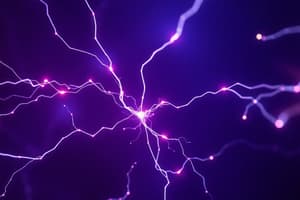Podcast
Questions and Answers
What are the fundamental interactions in atomic structure involving electrons and a nucleus?
What are the fundamental interactions in atomic structure involving electrons and a nucleus?
Electrostatic interactions
In what ways can electrostatic forces be advantageous in electric motors and generators?
In what ways can electrostatic forces be advantageous in electric motors and generators?
They offer advantages in certain applications
Where can a career in electrostatics lead to?
Where can a career in electrostatics lead to?
Working in academia, industry, national laboratories, and research institutions
What are some modern challenges in electrostatic research?
What are some modern challenges in electrostatic research?
How can students get involved in electrostatic research?
How can students get involved in electrostatic research?
What is the main focus of electrostatics in physics?
What is the main focus of electrostatics in physics?
What is the role of dielectrics in insulation and capacitors?
What is the role of dielectrics in insulation and capacitors?
How do electrostatic precipitators function?
How do electrostatic precipitators function?
What natural phenomena are caused by charge separation and electric fields?
What natural phenomena are caused by charge separation and electric fields?
What laws govern the forces and fields in electrostatics?
What laws govern the forces and fields in electrostatics?
Flashcards are hidden until you start studying
Study Notes
Electrostatic Physics: Exploring the Fundamentals and Applications
Electrostatics, a branch of physics that dives into the static electric and magnetic fields, is a foundational field with a wealth of applications. Let's explore this intriguing realm, starting with fundamental concepts and ending with real-world examples.
Charge, Fields, and Forces
Electrostatics is concerned with stationary charges and the electric fields they generate. Charged particles emit an electric field, which exerts forces on other charged particles. The electric potential, or voltage, indicates the strength of the electric field in a region. These forces and fields are governed by Coulomb's law and Gauss's law.
Applications and Examples
-
Insulation and Capacitors: Dielectrics, materials that don't conduct electricity, are used in insulation, reducing the risk of electrical shock. Capacitors, devices that store electric charge, make use of the electric field between charged plates.
-
Electrostatic Precipitators: These devices remove particulate matter from industrial exhaust by giving them a charge, causing them to be attracted and collected on an oppositely charged surface.
-
Charge Separation and Electric Erosion: In nature, charge separation between air and aerosol particles can cause lightning, while electric fields in clouds can lead to erosion of ice crystals.
-
Atomic and Molecular Physics: The electrostatic interactions between electrons and a nucleus are fundamental to the understanding of atomic structure and behavior.
-
Electrostatic Drives: Some types of electric motors and generators make use of electrostatic forces instead of electromagnetic forces, offering advantages in certain applications.
Research and Careers
Electrostatic research can focus on refining fundamental concepts, developing new technologies, and solving practical problems. As a career, electrostatics can lead to working in a variety of settings, including academia, industry, national laboratories, and research institutions.
Educational Opportunities
Undergraduate and graduate students can take courses in electrostatics, learning about the principles and applications of the field. Many physics departments offer research opportunities in electrostatics, and students can pursue related careers in academia, industry, and research.
Modern Challenges and Advances
Contemporary research in electrostatics tackles problems such as controlling electric field patterns in microelectronics, improving energy storage technologies, and designing more efficient insulation materials. Additionally, electrostatic research is being combined with other fields, such as plasma physics and nanoscience, to further explore the boundaries of physics and technology.
Whether you're exploring the fundamental principles of electrostatics or working on the cutting edge of technology, this area of physics presents endless opportunities for curious minds.
Studying That Suits You
Use AI to generate personalized quizzes and flashcards to suit your learning preferences.




